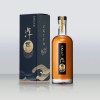The Kyoto psychology professor is making people all over the world doubt their eyes.
Truth be told I’m not a strawberry fan. In general, I prefer fruits that are juicer and not so tart, and while I wouldn’t say I hate strawberries, if you offered me one, I’d probably pass (unless it was covered with green tea chocolate).
That said, I at least know what strawberries are, and what they look like. They’re red, right?
Well, sometimes.
https://twitter.com/AkiyoshiKitaoka/status/836382313160171521Akiyoshi Kitaoka is a professor of experimental psychology at Kyoto’s Ritsumeikan University. A specialist in visual perception, Kitaoka doesn’t just provide instruction for his students, he also creates mind-bending illusions, which he shares through his Twitter account. His self-introduction tweet, by the way, is exactly like you’d expect of someone with his profession.
▼ Sit still, Akiyoshi! Oh, wait…you are.
I introduce myself. I live in Kyoto, Japan. I teach psychology in the Ritsumeikan University (立命館大学). I study visual illusions. pic.twitter.com/LNYGUoKa8G
— Akiyoshi Kitaoka (@AkiyoshiKitaoka) March 5, 2017
Getting back to those strawberries though, if the pixels in the image aren’t red, than what color are they? Those who’ve taken the time to collect samples show that they’re various shades of gray or cyan.
https://twitter.com/carsonmell/status/836411673552400384The illusion is the result of a phenomenon called color constancy, which is usually a good thing. In very simple terms, color constancy is what lets you continue to perceive an object as being the same color even if the color of the illuminating light changes. Even after you carry a piece of plain white paper into a room with a red light bulb, for example, your brain still understands that the paper itself is as white as it was before.
▼ Oranges that aren’t orange? So does that makes them gray-blues?
Oranges appear to be orange in color, though the pixels are gray or blue hue. pic.twitter.com/y2HyZFgZZr
— Akiyoshi Kitaoka (@AkiyoshiKitaoka) March 5, 2017
What makes things really startling is how subtle yet thorough the process can be. In the case of the strawberries, one could argue that common and prior knowledge that strawberries are red influences how Kitaoka’s photo is perceived, but what if we were talking about something that there’s no standard, preconceived color for, like a train? Color constancy still works, based on color cues your brain is trying to pick up on elsewhere in the image.
A train at the Liverpool station appears to be partly wrapped with reddish color, though the pixels are not. pic.twitter.com/BjALDkX6nQ
— Akiyoshi Kitaoka (@AkiyoshiKitaoka) March 5, 2017
A train appears to be partly wrapped with yellowish color, though the pixels are not. pic.twitter.com/E3ar2rCm0L
— Akiyoshi Kitaoka (@AkiyoshiKitaoka) March 5, 2017
A tram in Belgrade appears to be bluish, though the pixels are red hue. pic.twitter.com/Paxg0tVfTu
— Akiyoshi Kitaoka (@AkiyoshiKitaoka) March 5, 2017
Likewise, even if you’ve never been to Japan and don’t know that green and red are the most common colors for payphones and public mailboxes, respectively, in the country, you can still get fooled by these illusions.
Phones appear to be greenish, though the pixels are not. pic.twitter.com/88BShpstnM
— Akiyoshi Kitaoka (@AkiyoshiKitaoka) March 5, 2017
A mailbox appears to be reddish, though the pixels are not. しつこい。 pic.twitter.com/T3HoD5Kjt3
— Akiyoshi Kitaoka (@AkiyoshiKitaoka) March 5, 2017
Oh, and if you’re wondering what those strawberries originally looked like…
The original image of the strawberry cake. My wife made it. pic.twitter.com/RFRpwsDzEQ
— Akiyoshi Kitaoka (@AkiyoshiKitaoka) March 2, 2017
Now we’re all left to wonder what mind-blowing illusions will come next from the Kitaoka family kitchen.
Sources: Jin, IT Media, Twitter/@AkiyoshiKitaoka
Follow Casey on Twitter, where it’s impossible for him to look at optical illusions without getting mad at his brain.

 Thirsty? How about some cider made with Japanese cat nip?
Thirsty? How about some cider made with Japanese cat nip? What’s white and sweet and smells like your first love? This tart made from white strawberries!
What’s white and sweet and smells like your first love? This tart made from white strawberries! Optical illusions from Japanese Twitter leave us questioning the universe and reality 【Videos】
Optical illusions from Japanese Twitter leave us questioning the universe and reality 【Videos】 The gorgeous portraits of these Japanese women aren’t photos or CG, so what are they?
The gorgeous portraits of these Japanese women aren’t photos or CG, so what are they? Japanese city changes into beautiful Spirited Away lookalike once a year, and it’s happening now
Japanese city changes into beautiful Spirited Away lookalike once a year, and it’s happening now Kyoto Whopper divides customers at Burger King Japan
Kyoto Whopper divides customers at Burger King Japan Taking the Kyoto overnight bus for the first time
Taking the Kyoto overnight bus for the first time Starbucks Japan unveils second Holiday Frappuccino for 2024
Starbucks Japan unveils second Holiday Frappuccino for 2024 Japan’s caramel gacha machines offer sweet thrills, but do they deliver?
Japan’s caramel gacha machines offer sweet thrills, but do they deliver? Japanese burger chain no longer serves onion rings, but offers intriguing replacement【Taste test】
Japanese burger chain no longer serves onion rings, but offers intriguing replacement【Taste test】 Forbidden area at Japanese mountaintop shrine opens to the public for first time in 400 years
Forbidden area at Japanese mountaintop shrine opens to the public for first time in 400 years Hello Kitty isn’t a cat!? We called Sanrio to find out!
Hello Kitty isn’t a cat!? We called Sanrio to find out! Ghibli’s Princess Mononoke teams up with Foxfire for outdoor apparel collaboration【Photos】
Ghibli’s Princess Mononoke teams up with Foxfire for outdoor apparel collaboration【Photos】 New card game makes Japan’s saunas even steamier
New card game makes Japan’s saunas even steamier How to properly pronounce “Ghibli” and other fun trivia about the legendary animation studio
How to properly pronounce “Ghibli” and other fun trivia about the legendary animation studio One of Japan’s most beautiful hot spring towns announces new limits on number of day trippers
One of Japan’s most beautiful hot spring towns announces new limits on number of day trippers Berserk T-shirts coming to Uniqlo for launch of new Manga Curation line【Photos】
Berserk T-shirts coming to Uniqlo for launch of new Manga Curation line【Photos】 Mario Kart Happy Meal toys arrive at McDonald’s Japan, and SoraNews24 has the whole set!【Photos】
Mario Kart Happy Meal toys arrive at McDonald’s Japan, and SoraNews24 has the whole set!【Photos】 After cancelling Halloween, Tokyo’s Shibuya neighborhood cancels New Year’s Eve too
After cancelling Halloween, Tokyo’s Shibuya neighborhood cancels New Year’s Eve too Tokyo park’s sea of clouds, nighttime illumination, and cosplay days make now perfect time to visit
Tokyo park’s sea of clouds, nighttime illumination, and cosplay days make now perfect time to visit Samurai ritual suicide contest cancelled by organizer in west Japan
Samurai ritual suicide contest cancelled by organizer in west Japan Japanese job-quitting service contacted by other job-quitting service because employee wants to quit
Japanese job-quitting service contacted by other job-quitting service because employee wants to quit Flying dango: Unique tourist site where Japanese sweets are flown to you over a gorge
Flying dango: Unique tourist site where Japanese sweets are flown to you over a gorge American jackass tourist arrested after carving name into gate at Tokyo’s Meiji Shrine【Video】
American jackass tourist arrested after carving name into gate at Tokyo’s Meiji Shrine【Video】 Nintendo’s controller capsule toys are so cool, even the machine you buy them from is awesome【Pics】
Nintendo’s controller capsule toys are so cool, even the machine you buy them from is awesome【Pics】 Tokyo Disneyland loses top-attendance crown for Japanese theme parks for second year in a row
Tokyo Disneyland loses top-attendance crown for Japanese theme parks for second year in a row Ghibli Park debuts first winter illumination display with Howl’s Moving Castle theme
Ghibli Park debuts first winter illumination display with Howl’s Moving Castle theme Pringles releases a limited-edition sweet flavour in Japan
Pringles releases a limited-edition sweet flavour in Japan Sanrio and magical girl anime PreCure join forces for new merch line【Photos】
Sanrio and magical girl anime PreCure join forces for new merch line【Photos】 What’s the deal with akebi, the perfectly purple, alien-like fruit that’s in season now in Japan?
What’s the deal with akebi, the perfectly purple, alien-like fruit that’s in season now in Japan? McDonald’s new Happy Meals offer up cute and practical Sanrio lifestyle goods
McDonald’s new Happy Meals offer up cute and practical Sanrio lifestyle goods Foreign tourists on Shinkansen bullet train break suitcase etiquette, angering local passengers
Foreign tourists on Shinkansen bullet train break suitcase etiquette, angering local passengers [Deleted] Article written for April Fool’s Day 2018
[Deleted] Article written for April Fool’s Day 2018 Japanese government to make first change to romanization spelling rules since the 1950s
Japanese government to make first change to romanization spelling rules since the 1950s Foreigner’s request for help in Tokyo makes us sad for the state of society
Foreigner’s request for help in Tokyo makes us sad for the state of society Ghibli founders Toshio Suzuki and Hayao Miyazaki contribute to Japanese whisky Totoro label design
Ghibli founders Toshio Suzuki and Hayao Miyazaki contribute to Japanese whisky Totoro label design Japanese convenience store Family Mart announces abolishment of eat-in spaces
Japanese convenience store Family Mart announces abolishment of eat-in spaces Princesses, fruits, and blacksmiths: Study reveals the 30 most unusual family names in Japan
Princesses, fruits, and blacksmiths: Study reveals the 30 most unusual family names in Japan Life-size vibrating Legend of Zelda Master Sword for sale from Nintendo【Photos】
Life-size vibrating Legend of Zelda Master Sword for sale from Nintendo【Photos】 Studio Ghibli releases free-download board game — Here’s how to play it without reading Japanese
Studio Ghibli releases free-download board game — Here’s how to play it without reading Japanese Peach-scented and flavored strawberries seriously trip us up, still taste deliciously sweet
Peach-scented and flavored strawberries seriously trip us up, still taste deliciously sweet Matcha green tea meets strawberries in Japan-exclusive drinks from The Coffee Bean & Tea Leaf
Matcha green tea meets strawberries in Japan-exclusive drinks from The Coffee Bean & Tea Leaf Starbucks Japan’s new strawberry Frappuccinos are so social media-savvy their names are hashtags
Starbucks Japan’s new strawberry Frappuccinos are so social media-savvy their names are hashtags Is Denny’s Japan’s new ultra-expensive Amaou strawberry parfait worth it?【Taste test】
Is Denny’s Japan’s new ultra-expensive Amaou strawberry parfait worth it?【Taste test】 Free ultra-low-res stock art website launched by former Nintendo designer
Free ultra-low-res stock art website launched by former Nintendo designer 19 pencil drawings that trick your mind into thinking they’re 3-D
19 pencil drawings that trick your mind into thinking they’re 3-D These ambiguous objects create such mind-blowing optical illusions, we almost believe it’s magic
These ambiguous objects create such mind-blowing optical illusions, we almost believe it’s magic Attack on Titan teas are selling out faster than a giant can eat a human
Attack on Titan teas are selling out faster than a giant can eat a human What colors of clothing will keep you cooler in summer? Japanese researchers experiment
What colors of clothing will keep you cooler in summer? Japanese researchers experiment Tokyo’s newest mascot character: a smiling bright pink turd laid by Japan’s most famous dog【Vid】
Tokyo’s newest mascot character: a smiling bright pink turd laid by Japan’s most famous dog【Vid】 Cold Stone Creamery Japan’s special year-end takeout box is perfect if you have a sweet tooth
Cold Stone Creamery Japan’s special year-end takeout box is perfect if you have a sweet tooth New dining out initiative enrols the Evangelion cast, stars themed dishes and merchandise
New dining out initiative enrols the Evangelion cast, stars themed dishes and merchandise Guinness World Record-breaking strawberry found in Fukuoka and it’s delicious
Guinness World Record-breaking strawberry found in Fukuoka and it’s delicious Starbucks Japan adding crunchy blooming sakura topping option to all Frappuccinos this spring
Starbucks Japan adding crunchy blooming sakura topping option to all Frappuccinos this spring
Leave a Reply